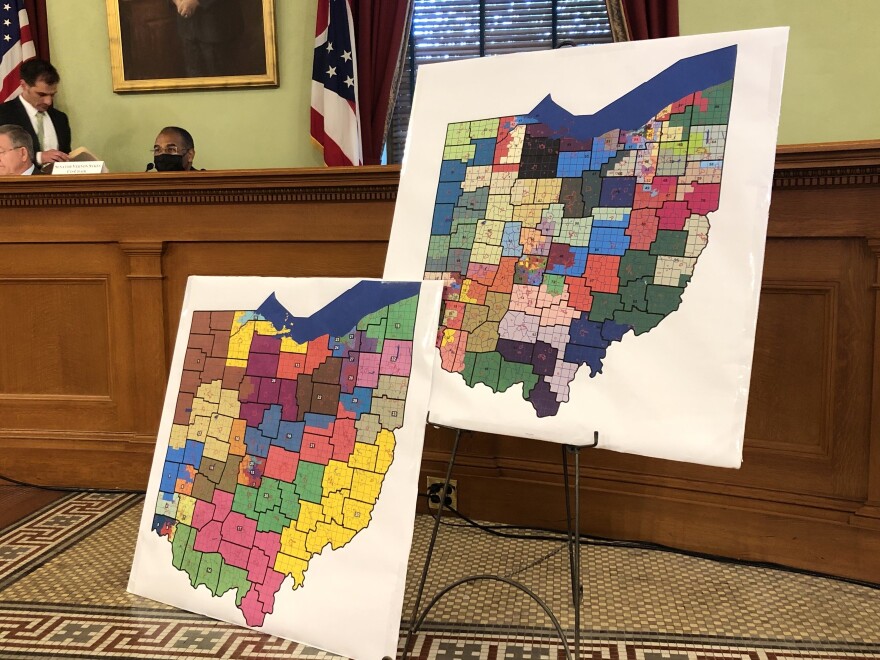The Ohio Redistricting Commission has adopted an official proposal for the new state House and Senate district maps. Now leaders will go to different parts of the state to hear public comment on the maps that were drawn by the Republican caucuses.
The majority caucuses in the House and Senate unveiled their proposal for new district lines for the 99 House seats and 33 Senate seats during a commission meeting on Thursday.
Leaders of those two caucuses, House Speaker Bob Cupp (R-Lima) and Senate President Matt Huffman (R-Lima), said they did not analyze how those districts broke down proportional to statewide election results, where the state has voted about 54% Republican and 46% Democrat.

The voter-approved constitutional change to the state legislative redistricting process said the maps should correspond closely to the statewide preferences of the voters of Ohio based on the last 10 years of general election results.
"Those will be calculated obviously as we go forward with a hearing process," Cupp said. When pressed on how did they draw their maps without knowing the partisan breakdown, Cupp said, "The instructions were to draw a map that complied with the constitution."
An early analysis by a national expert suggested the maps will tip heavily toward Republican supermajorities continuing in the Ohio House and Senate, with as many as 67 of 99 House districts and 25 of 33 Senate districts likely to lean to the GOP.
Sen. Vernon Sykes (D-Akron), co-chair on the commission, isn't buying that the Republicans drew their maps without knowing the partisan proportions.
"To say that they don't even know what the distribution is. To present a map before this commission and say they're unaware of what it is and didn't consider it at all. I think it's disingenuous," Sykes said.
Advocates for non-gerrymandered maps were at the redistricting commission meeting, with many expressing their discontent with the commission process. The public didn't see the Republican-made maps until the morning of the meeting and the commission accepted the map just a few hours later.

Some of those who offered comments compared to the redistricting process 10 years ago when maps were drawn behind closed doors in a Columbus hotel room.
They said the reforms passed by voters in 2015 were supposed to bring more accountability and transparency to the process.
"I suppose the cheating out in the open is a slight improvement over the secretive cheating used in 2011 to create our current district maps,” said Melissa Sull, Gahanna.
While Andrea Yagoda, Columbus, told the commission, "You are not going to silence me for the next 10 years. I have had enough. Ohioans have had enough. We did not vote for this. We all worked hoping that you would act in good faith and do what the voters want you to do. This is not what we voted for."
Huffman (R-Lima) said the mapmakers on his staff were instructed to not take racial and demographics data into consideration.
"It's illegal to use race in drawing districts. That's a violation of federal law. Now, there's a mention of the Voting Rights Act. If the government sees that there's a compelling state interest based on evidence presented, to do that. But if we said, use race and drafting these districts, the federal government's going to say you can't do that," Huffman said.
Deidra Reese, Ohio Unity Coalition, countered Huffman's comments, "You can actually look at race as a criteria. It just cannot be the only criteria."
Reese added that she felt disgusted when she heard racial data was taken into account, "I felt very invisible. I felt unheard. I felt like, like I don't even count whatsoever. And that's what this is all about. We counted people in the census. We're supposed to have representation. You want to make certain that people have the ability to influence who is going to actually represent them. That's what it's all about."
The Ohio Redistricting Commission will now hold three public hearings around the state to hear more comment on the Republican-made maps that have been adopted. Those meetings will be in Dayton, Cleveland and Columbus, starting on Sunday.
The commission needs approval by the two Democratic members in order to have maps that last ten years. It can pass maps without Democratic support, but they would have to reconvene in four years to draw maps again.
Copyright 2021 The Statehouse News Bureau. To see more, visit The Statehouse News Bureau.




